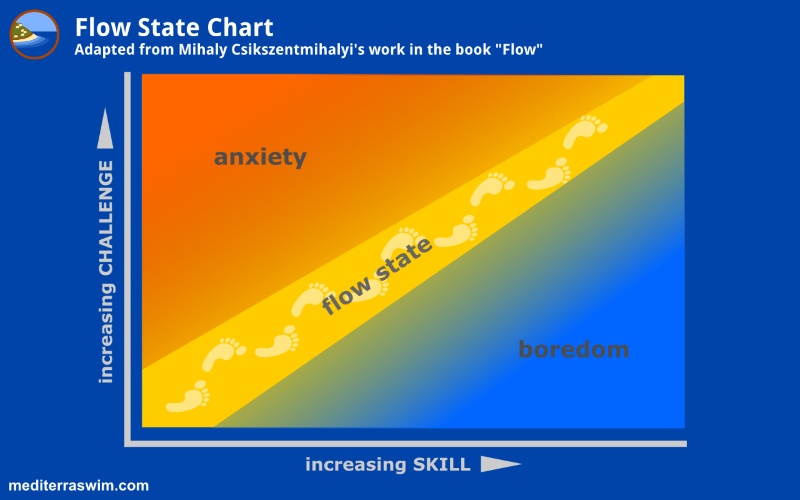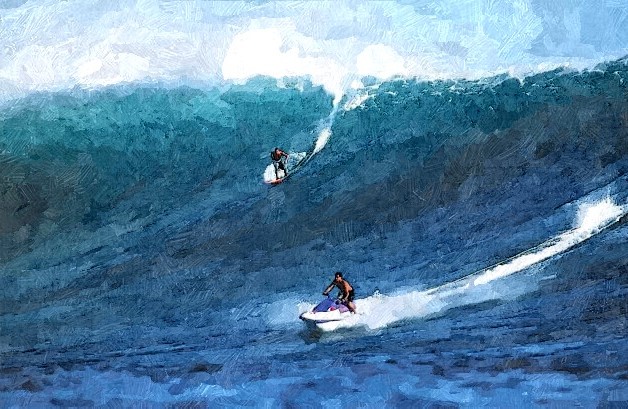Forums › Library › Knowledge Base › Challenge Multipliers
Please type your comments directly in the reply box - DO NOT copy/paste text from somewhere else into the reply boxes - this will also copy the code behind your copied text and publish that with your reply, making it impossible to read. Our apology for the inconvenience, but we don't see a convenient way of fixing this yet.
-
AuthorPosts
-
August 1, 2014 at 15:38 #2651
Admin Mediterra
KeymasterNote: I may use the term “Challenge Multipliers” or “Complexity Multipliers” interchangeably. Sometimes one title fits into an explanation better than another.
In our practices we are trying to achieve two things: improvement in our capabilities, and improvement in our enjoyment of practice and performance.
One concept captures both: Flow State.

This is when both skill and satisfaction in the act of practice (or in the performance) are in their peak growth state.Too much challenge that is far beyond your current skill and you get anxiety or frustration, and perhaps injury. Too little challenge and you get bored, the mind wanders and skill-growth diminishes.
The practical application for this is to design practices that provide just enough challenge that is not too much nor too little. This is as much of an art as it is a science. And it is profoundly personal.
So, what virtually everything in my coaching service is aimed at is to guide you into the understand and skills you need to keep yourself in Flow State while practicing (and racing, if you do that) – and, hopefully to carry that over into other areas of your life too!
In order to design practices that provide the optimal amount of challenge for you, you need to choose the distances, the number of repeats, the intensity level, the focal points, and the feedback metrics to put yourself in that zone. Following the guidelines we give you in Total Immersion is the science part (principles), but making it fit you personally is the art part (personalization).
Here are the nuts and bolts:
We can customize the challenge level of the practice set for any swimmer at any skill or fitness level – we do it by increasing the neuro-muscular complexity of the task.
Remember, the brain’s main function (according to some neuro-scientists) is ‘to manage information and energy’. The brain controls the production of energy, and it controls the firing of muscles, which use the energy. Information allows the brain to make decisions about where and how energy should be used, which muscles should be activated. Fitness is the body’s ability to convert fuel to create power. Technique is the brain’s ability to skillfully apply that that power where, when and how it is needed to get the job done well.
So, to provide complete training we must challenge the brain while we challenge the body.
Once you find a certain skill challenge becoming relatively easy (even ‘automatic’), you can turn up the neuro-muscular challenge a notch to expand or to further deepen your skill and fitness at the same time (in TI we understand that these two cannot be separated).
Ways we can do this:
- Change Focal Points
- Blend Focal Points (e.g. from holding A to holding AB, from AB to ABC)
In combination with Focal Points, we can adjust these metric challenges (roughly in ascending order of difficulty):
- Add stroke counting (simply counting).
- Add SPL control (holding SPL steady).
- Lengthen the stroke (lower SPL by -1).
- Add comfortable Tempo (using the beep of a Tempo Trainer – simply keeping time).
- Change the point in the stroke at which the Tempo beep is synchronized to.
- Add slower-than-comfortable Tempo.
- Add faster-than-comfortable Tempo.
- Add more distance by adding more repetitions or rounds (which means holding attention more often).
- Add more distance by making each repetition or interval longer (which means holding attention for longer spans of time).
- Add SPL control and comfortable Tempo control at the same time.
- Add SPL control and slower-than-normal Tempo control at the same time.
- Add SPL control and faster-than-normal Tempo control at the same time.
- Convert passive Rest Intervals into active Rest Intervals (rather than sit at the wall, do a drill or swim gently).
- Make shorter or remove Rest Intervals.
No matter the current level of neuro-muscular skill and fitness you feel you have, you can take any practice in this program, modify it to take you to a new level of skill and fitness.
In this way, the steps of the TI Advanced Training Method can be followed by any swimmer at any performance level. The same problems can be recycled, so to speak, once you add greater complexity to the problem. Each skill in this program can be re-solved to create greater skill-resilience at higher speed, over longer distance. And, even the foundational skills (Step 1) can be improved and refined to finer and finer level of detail that you only notice once you turn up the complexity of the problems you try to solve.
This is a primary reason why I don’t just write practices for each of you. I give you some ideas to start with, but then I expect you to start adjusting those to take you into our own Flow State – something I cannot ultimately do for you, only coach you in how to find. I can tow you up to the edge of that zone, but you’ve got to ride into it and keep yourself there.
-
This topic was modified 7 years ago by
Admin Mediterra.
-
AuthorPosts
- The topic ‘Challenge Multipliers’ is closed to new replies.

